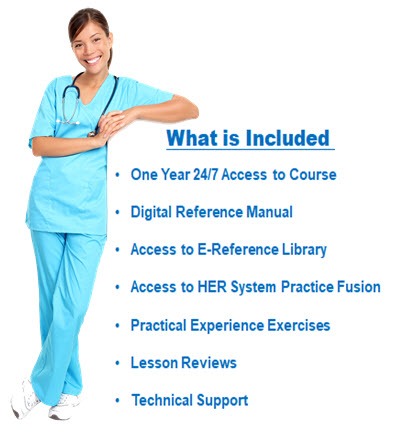 MEDICAL ELECTRONIC HEATH RECORDS
 |
|
Click to enlarge image(s)
|
| MEDICAL ELECTRONIC HEALTH RECORDS P |
Medical professionals who work with important patient data are required to abide by federal and state laws, as well as accreditation and regulatory agency requirements that govern the handling of patient information. As such, it is extremely important for medical professionals to remain up to date on the emerging technological trends as well as regulatory requirements.
This course focuses on the common practices and procedures performed by medical office professionals using Electronic Health Records. The course employs a hands-on approach to teach students how to input, modify, and maintain patient information, schedule appointments, upload external documents, and create and print reports. These skills are required to work within the medical field for both large hospital-based systems and small local practices. After completing this course, students will possess the necessary skills to access information contained within an EHR system and will be able to use this technology to assist in providing high quality care.
EHR SYSTEM There are a number of EHR systems available in the market. For this course, we will be using a product named Practice Fusion which is a popular commercially available EHR system that has been designed for and is used in outpatient settings. Tasked with various exercises and assignments utilizing this EHR system, students will gain a working knowledge that will equip them when entering into the health care environment. |
Course Learning Outcomes: Upon completion of this course, students are expected to be able to:
- Identify and enter/manipulate basic demographic and clinical health information
- Analyze and manage security on an Electronic Health Record system.
- Enter diagnosis and procedure codes
- Enter charges and payments from patients
- Create and print patient statements
- Create and analyze reports
- Perform routine EHR clinical and administrative tasks
|
Lesson 1: Introduction to the Administrative Medical Assistant
This lesson covers the following topics:
- History of Medicine
- Education and Training
- National Departments/Agencies that focus on Health
- Role and Duties
- Attributes
- Professionalism
- Etiquette
- Boundaries
- Scope of Practice
- The Healthcare Team
- Types of Medical Practices
Lesson 2: Medical Ethics, Law and Compliance in the Health Care Setting
This lesson covers the following topics:
- History of Ethics in Medicine
- Law and Ethics
- Ethics and Professionalism
- Medical Liability Lawsuit
- Risk Management
- Healthcare Compliance
- Patient Rights and Responsibilities
- Informed Consent
- Risk Assessment
- HIPAA
- The Privacy Rule
- The Security Rule
- Office of Civil Rights
Lesson 3: Communication in the Medical office
This lesson covers the following topics:
- Maslow’s Hierarchy
- Communication
- Lessons in Active Listening
- Direct and Assertive Expression
- Dealing with Conflict
- Written Communication
- Types of Correspondence
- Formatting
- E-mail
- Telephone Techniques
- Incoming and Outgoing Mail
- Patient Education
- Effective and Inclusive Conversation
Lesson 4: Managing Health Information
This lesson covers the following topics:
- Medical Records
- Creating a Patient Chart
- Filing Systems
- Ownership, Transportation, Retention and Destruction
- Electronic Health Records
- Legislation
- Health Information Exchange (HIE)
- Maintaining Security and Confidentiality
Lesson 5: Patient Processing and Daily Operations
This lesson covers the following topics:
- Scheduling
- Managing Appointments
- Scheduling Methods
- Special Scheduling Situations
- Patient Reception
- Patient Check-In
- Payment Policies
- Patient Check-Out
- Referrals
- Medical Office Inventory
- Follow Up
Lesson 6- OSHA Compliance and Infection Control
This lesson covers the following topics:
- OSHA
- Pathogens and Infection
- The Disease Process
- Prevention
- Handwashing
- Personal Protective Equipment
- Sharps Injury
- Cleaning and Disinfection
- Respiratory Hygiene
- Waste Management
- Ergonomics
|
 |
|
Categories
 AVAILABLE COURSES
|
.jpg)
.jpg)